You will also be interested
[EN VIDÉO] Perseverance, in search of life on Mars Perseverance, this is how NASA has decided to name the rover it will send to Mars in the summer of 2020. A rover from which researchers expect a lot. He will be the first to collect rock samples to be brought back to Earth. Objective: to find traces of microbial life.
It is one of main missions of the Perseverance rover : find traces of life in the rocks of the Martian soil or at least try. Because these are not fossils organizations you are looking for Perseverancebut molecules, more or less complex, which would have been synthesized by biological processes. the rover Curiosity would have taken the first step by confirming the presence of organic molecules (methane and carbon compounds) on Mars. If Perseverance succeeded in finding more complex biomolecules, it could mean that the planet would have experienced the beginnings of even very rudimentary organic life. A rather exciting prospect!
The problem of UV radiation
This goal is also one of the next rover that should join Mars: Rosalind Franklin. This new rover of the ExoMars program of ESA and Roscosmos will carry on board a suite of instruments in order to perform Raman spectroscopic measurements. The Raman spectroscopy is a chemical analysis method that identifies the structure of molecules present in a sample. This type of instrument already equips the Perseverance rover. If this method is effective on Earth, and very widely used to detect biomolecules, things seem to be complicated on Mars.
Because there is a major difference between Mars and Earth: theatmosphere. If Mars does have one, it is however much thinner than that of Earth. However, the Earth’s atmosphere plays an essential role in the preservation of life: it stops a large part of the radiation from ultraviolet (UVR), which are harmful in high doses to living organisms.
Is this method of analysis best suited for Perseverance?
Could biomolecules remain stable under the fire of solar radiation impacting the Martian soil? Some studies prior to the mission have shown that while the rate of degradation is certainly very high in the first centimeters of the surface, the regolith nevertheless had the ability to protect certain biomolecules. Considering this hypothesis, however, there is another problem, linked to the method of analysis this time. Indeed, if the scientists showed that biomolecules could remain detectable despite the atmospheric conditions of Mars, these tests had not been carried out using Raman spectroscopy to carry out the analyses.
A team of researchers has therefore come to question the analytical capacity of this type of instrument under Martian conditions. A series of experiments (Biomex) was thus carried out on board the international space station. Seven different types of biomolecules were exposed to solar radiation outside the station for 469 days. They were mixed with analogues of Martian regolith in order to better simulate the environmental conditions prevailing on the Red Planet. The samples were then analyzed with Raman spectroscopy.
The regolith signal overlaps that of the biomolecules
The researchers then realized that, during the analyzes of the samples most exposed to UVR (simulating those of the Martian surface), the signal associated with the minerals regolith partially covered or even totally masked the signal associated with the biomolecules. For example, the particularly strong signal from hematite, a mineral very present on Mars, falls in exactly the same range of values as that of the chlorophyllof the cellulose or other biomolecules, preventing their detection. Samples containing a lot ofclay proved to be even more difficult to analyze. However, this mineral is considered to be the matrix most likely to have preserved organic molecules on Mars.
This study, published in Science Advances, shows the difficulty of analyzing samples containing mineral phases using Raman spectroscopy, in the presence of high UVR exposure. On the other hand, samples located at depth and therefore more protected from UV radiation, could remain correctly detectable with this method.
Perseverance, which can only analyze surface samples, could therefore completely miss a biosignature, even if biomolecules were indeed present in the analyzed sample!
Drilling deep, Rosalind Franklin’s solution
All hopes therefore turn to the Rosalind Franklin rover, which will have the ability to drill up to 2 meters deep to recover UV-protected samples.
A modification of the analysis technique by Raman spectroscopy also shows good results on Earth, but the equipment still needs to be miniaturized before it can be integrated into a potential Mars mission. In the meantime, a new data processing approach could nevertheless make it possible to extract certain information from the samples analyzed by Perseverance. Otherwise, you will have to wait the return of the samples to Earthscheduled for 2033.
Interested in what you just read?
